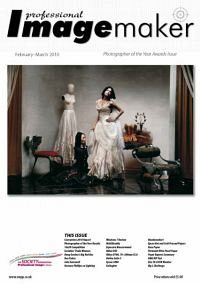articles/Lighting/whataboutlight-page4
What about the Light? - seeing is Believing - part 4 of 1 2 3 4
Published 01/02/2010

In image No 4, her head is very slightly turned toward the camera, just enough to allow a little light on to her right cheek and creating a more defined butterfly pattern below her nose. This effect would be created with the studio light at the same 45 degree angle of the soft-box and has not changed but it has been slightly feathered out toward the camera.
In image No 6, we have her more directly addressing the camera while the position of the light is unchanged. The effect is that we have a catch-light in her left eye and reflected light in her right eye that is arguably an incorrect lighting techniques. At the same time there is a slight imbalance of the overall lighting pattern because we do not have a split lighting pattern but one that renders her face in two slightly different ways. This might appeal to some but conventionally this is somewhat frowned upon, though it is still a very nice rendition.
In image No 8, we have a more conventional lighting pattern created by a double-diffused soft-box that produces a soft light that is very kind, especially to older subjects who prefer not to show signs of age. While the overall lighting is soft, it also more evenly lights the mask of the face where we need the forehead, cheeks and chin to be nicely illuminated. It is the same as having the soft-box at approximately 45 degrees to both subject and camera and very slightly feathered inward. It retains the butterfly pattern and the catch -lights with nice illumination in both eyes.
In image No 5, her head has turned very slightly toward the light and the equivalent to feathering the light out, or slightly toward the camera. This slightly opens up the right side of her face and enhances the butterfly lighting pattern below her nose and allows catch-lights in both eyes.

In image No 7, her head is turned more toward the light and it is the equivalent to feathering the soft-box slightly toward the subject, thereby creating a greater ratio as the right side of her face has no specula highlight on her cheek, rendering it relatively flat. Normally what we would seek to do is have a little specula highlight on both cheeks so that the mask of the face is properly lit. This rendition is not bad, but also not what is most desirable.
In images 6, 7 and 8, a 42'' white, Monte Illuminator reflector, a Westcott product available from the Flash Centre in a 6 in 1 kit, was used to slightly increase the fill light (by a little less than a quarter f-stop).
So what has this taught us?
It has taught us that we need to learn to see light and not rely on using lockdown lighting systems that require marks to be placed on the floor indicating where each light is supposed to be placed. It also teaches us that there are many opportunities to create portraits in the most unexpected locations. It also reminds us that we should take our camera with us almost everywhere because you never know when an opportunity may present itself to create a great portrait.
Please Note:
There is more than one page for this Article.
You are currently on page 4
- By Norman Phillips
What about the Light? - seeing is Believing page 1 - What about the Light? - seeing is Believing page 2
- What about the Light? - seeing is Believing page 3
- What about the Light? - seeing is Believing page 4
1st Published 01/02/2010
last update 09/12/2022 15:00:19
More Lighting Articles
There are 0 days to get ready for The Society of Photographers Convention and Trade Show at The Novotel London West, Hammersmith ...
which starts on Wednesday 15th January 2025





